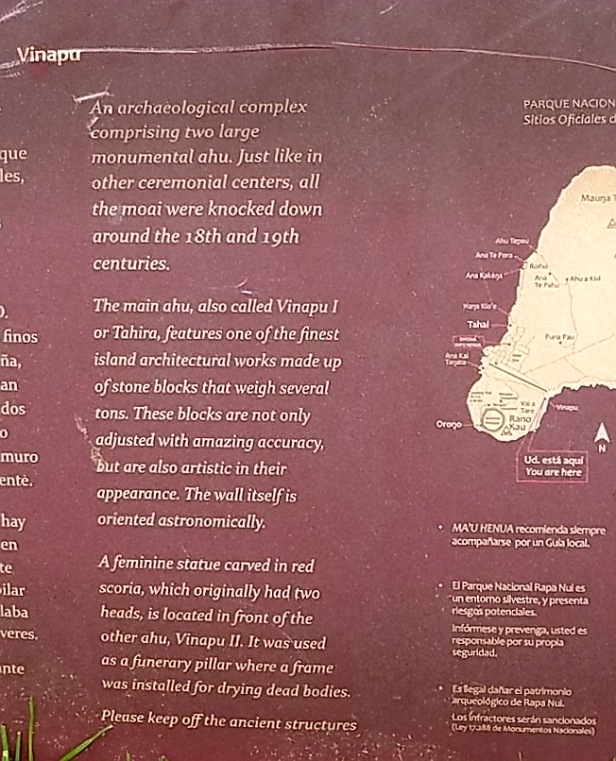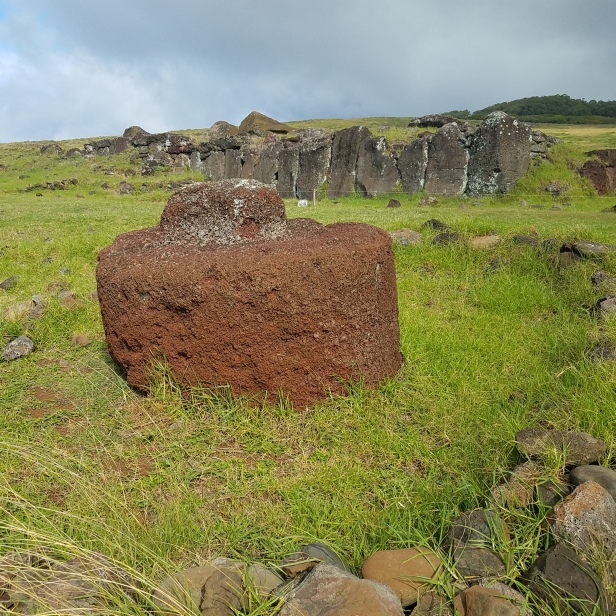Because this trip was a last-minute decision, there was no time to do extensive research about Easter Island. About all I knew was there were statues and Easter Island was in the middle of nowhere in the South Pacific Ocean. To remedy my ignorance, I scheduled two small-group, guided tours of the island’s archaeological sites. At the Orongo site, I was stunned to learn that, after rejecting the religion of their ancestors and toppling the statues (moai) erected to them, the islanders created a religion that was based on what was essentially a game show.
Other posts about the Easter Island trip:
Priority Pass Lounge Review – Primeclass Pacifico Condor Lounge Santiago, Chile
Flying the Great White Whale – LATAM Stealth 777-200 Santiago to Isla de Pascua, Chile
This Trip To Easter Island Really Got Me thinking Part 1 – Chez Jerome Easter Island B & B Review
This Trip To Easter Island Really Got Me Thinking Part 2- Hanging Out in Hanga Roa
This Trip To Easter Island Really Got Me Thinking Part 4 – Orongo And The Birdman Cult
This Trip To Easter Island Really Got Me Thinking Part 5 – Lunch With A Rapa Nui Family
Rapa Nui National Park
In 1935, the government of Chile established Rapa Nui National Park to preserve the archaeological remains of its unique Polynesian culture. Most archaeological sites are located in the park, which covers nearly 50% of the island’s surface. The island has nearly 900 statues called moai (like toy) and 300 platforms called ahu (like achoo without the ch sound).

Rapa Nui National Park is a UNESCO World Heritage Site. In 2017, the Chilean National Forestry Service transferred administrative control of the park to the Ma´u Henua Polynesian Indigenous Community. The national park is the first autonomously administered indigenous institution on the island.
Rapa Nui people are in charge of the management, preservation, and protection of the historical lands and monuments. All revenue the National Park generates is used on the island to conserve its natural heritage. Islanders themselves now protect the natural and archaeological resources they inherited from their ancestors.

Several companies and individuals operate tours in the park, or tourists can explore sites on their own. Admission costs $80 and must be paid for in U. S. dollars or Chilean Pesos in cash. Purchase tickets at the office in Hanga Roa. It seems you cannot buy park tickets from tours.
Anakena
The tour started at Anakena, the spot where Polynesian colonizers landed upon reaching Rapa Nui. While experts vary the date of the first landing by several hundred years, the location of the landing is undisputed. Rapa Nui has only two sandy beaches, and the Rapa Nui are certain the landing was here.

Estimates of the date of the landing range from 300 A.D. to 1200 A.D. The huge discrepancy in those estimates underscores how little is known about the history of the island and the civilization that was created here.
According to widely accepted oral tradition, Hotu Matu’a, a Polynesian king landed here after sailing a two-canoe flotilla across hundreds and hundreds of miles of open ocean and established the first settlement on Rapa Nui. Tradition states that the king’s wife gave birth to a son shortly after arriving on Rapa Nui.

Palms were recently planted at Anekena to recreate the environment that was prevalent when the colonists arrived. This is the only palm grove on the island that I saw.

There are two ahus at Anakena, Ahu Nao-Nao and Ahu Ature. Ahus are the platforms upon which the moai stand. Like nearly all moais, the moai at Anakena face the island interior and have their back to the sea. These moai are 4-5 meters tall.


Ahu Ature
In terms of facilities for tourists, Anekena is the most developed site in the park. There is a good-sized paved parking lot, souvenir shops, cafe and restrooms. It is a good spot for school outings.

Te Pito Kura
This location is famous because it is the site of the largest moai ever erected over an ahu. Moai Paro was 10 meters tall and weighed over 80 tons. The Rapa Nui poeple toppled it along with all other moai when the population revolted against the religion and culture these statues represented.

An oval shaped stone next to toppled moai carried great importance for islanders. Its name Te Pito O Te Henua has been translated as “the navel of the world.” Residents believed Rapa Nui and this point were the center of the surface of the Earth. Some historians suggest that term Te Pito O Te Henua was also used as the name of the island before the arrival of Europeans.

Puna Pau
Puna Pau is a quarry in a small crater on the outskirts of Hanga Roa. Puna Pau was the sole source of the red rock the Rapa Nui people used to carve the pukao (topknots) that they put on the heads of some moai.

The site is littered with pukao that were abandoned in various stages of construction and transportation when the people stopped constructing moai.


Ahu Akivi
Ahu Akivi is another group of seven moai as at Anakena. Unlike Anakena, these maoi face the ocean.

This ahu has an astronomical orientation. The moai exactly face the sunset during the Spring equinox and have their backs to the Fall equinox. In the southern hemisphere, the Spring equinox occurs in September and the Fall equinox occurs in March.
Vinapu
Vinapu shows what the archaeological sites on Rapa Nui looked like after the moai toppling and before restoration efforts.

All of the moai are in pieces. It must take a lot of work to figure out the original configuration and purpose of the ahus.



Final Thoughts
Rapa Nui is the most remote populated island in the world. It had no contact with outside influences for several centuries. The population developed a unique and mysterious culture. They devoted a significant amount of resources to the construction of monuments to their ancestors. After first contact with Europeans something caused the Rapa Nui people to reject their religion and topple the moai that they had devoted so much energy and resources to building. What happened? There are clues which will be discussed in another post.
We know that after destruction of the moai, the Rapa Nui people created a remarkably quirky religion based on the Birdman cult. That will be covered in the next post. What do you think of the culture that was first established on Rapa Nui?

So much useful information! Thanks 🙂
LikeLiked by 1 person
Rapa Nui is a very interesting island with wonderful people. I hope you decide to go.
LikeLiked by 1 person
Thanks for reading the blog. I really enjoy sharing info from my trips.
LikeLike
you’re a great teacher, my friend!! thanks for the enlightening piece.
LikeLike